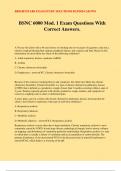Exam (elaborations)
BSNC 6000 Mod. 1 Exam Questions With Correct Answers.
- Course
- Institution
BSNC 6000 Mod. 1 Exam Questions With Correct Answers. A 58-year-old client with a 40-year history of smoking one to two packs of cigarettes a day has a chronic cough producing thick sputum, peripheral edema, and cyanotic nail beds. Based on this information, he most likely has which of the foll...
[Show more]



